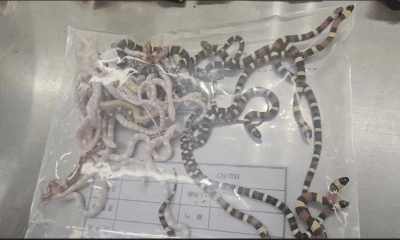Aviation
Unsecured Penguin in Cardboard Box Caused South African Helicopter Crash
In one of the most unusual aviation incidents in recent memory, a helicopter crash in South Africa was caused by an unsecured penguin in a cardboard box, according to an official report released this week by the South African Civil Aviation Authority (SACAA). The helicopter crash occurred during an aerial survey flight over Bird Island, off the Eastern Cape, near Gqeberha. The helicopter, after completing its survey, landed to pick up a single penguin for transport back to Port Elizabeth. The penguin was placed in a cardboard box and held on the lap of a passenger, identified as a specialist involved in the operation.
Just moments after takeoff—approximately 15 meters (50 feet) above the ground—the box slid off the passenger’s lap. As it moved, the box impacted the helicopter’s cyclic pitch control lever, pushing it to the far-right position. This sudden movement caused the aircraft to roll uncontrollably.
According to the report, the pilot was unable to regain control. The main rotor blades struck the ground, and the helicopter ultimately crashed onto its starboard side around 20 meters from its takeoff point. Remarkably, no one on board was injured in the helicopter crash—not the pilot, the passengers, or the penguin.
While the outcome was fortunately free of fatalities or injuries, the incident has raised serious concerns about aviation safety procedures and the handling of live animals during flight.
Helicopter Crash: Penguin Transport Ignored Safety Regulations
The SACAA’s investigation found that the penguin’s transport had not been included in the pilot’s official risk assessment before the flight. This omission constituted a violation of South Africa’s Civil Aviation Regulations (CAR) of 2011. The report emphasized that while the pilot did perform a general risk assessment for the mission, the addition of an unsecured animal in a cardboard box was never formally evaluated.
“The lack of secure containment for the penguin created a dangerous situation,” the SACAA concluded, noting that all live animal transport must comply with strict aviation safety standards.
The authority further stated that proper cargo evaluation—including consideration for the shifting of items during flight—is essential in all situations, regardless of the size or nature of the cargo. “The absence of a proper, secured crate meant that the penguin’s containment was not suitable for the flight conditions,” the report said.
US Tariffs on Uninhabited Penguin Island Spark International Confusion
Lessons Learned and Safety Recommendations
Although the penguin emerged from the helicopter crash unscathed, the SACAA warned that the consequences could have been far worse. The report serves as a reminder of the importance of following established safety protocols, particularly when dealing with non-standard or live cargo. The findings have prompted renewed calls for strict enforcement of animal transport regulations and heightened awareness among pilots and flight coordinators.
While the penguin has not been publicly identified, and its reason for transport remains unclear, its unexpected role in aviation safety history is now etched into South African aviation records.
In short, the flight that began with a birdwatching mission ended with a helicopter crash—caused by a Penguin in a box.






































